Linux Space Cube ready for blast-off
Aug 28, 2008 — by Eric Brown — from the LinuxDevices Archive — 24 views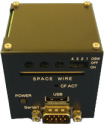 Japanese manufacturer Shimafuji is readying a two-inch cubed computer that runs Red Hat Linux on 1GB of flash. The Space Cube is equipped with a MIPS-based NEC VR5701 processor, 64MB RAM, and numerous I/O connections, including a Firewire-like “SpaceWire” port designed for spaceflight.
Japanese manufacturer Shimafuji is readying a two-inch cubed computer that runs Red Hat Linux on 1GB of flash. The Space Cube is equipped with a MIPS-based NEC VR5701 processor, 64MB RAM, and numerous I/O connections, including a Firewire-like “SpaceWire” port designed for spaceflight.
Designed primarily to control and coordinate sensors and other devices on space stations and spacecraft, the Space Cube measures only 2 x 2 x 2.1 inches (52 x 52 x 55mm), and runs on a 5V power supply. According to the Shimafuji site, which dubs the latest model of the Space Cube as the SEMC5701B, the VR5701 processor is clocked between 200MHz and 300MHz.

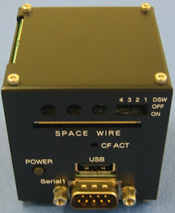
Two views of the Space Cube, with the SpaceWire connection shown on the right
(Source: Shimafuji)
The Space Cube runs on only 64MB SDRAM and 16MB internal flash memory, with the CF slot handling a supplied 1GB card that holds the Red Hat Linux distribution. The device outputs video in XGA (1024×768) format, and offers Ethernet, USB, and serial ports, as well as audio I/O and a JTAG connection for debugging.
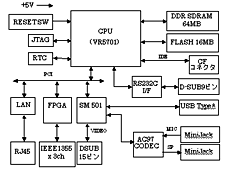
Space Cube block diagram
(Source: Shimafuji)
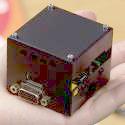 The earlier “Teacube” (Click for details) |
Tangerines and Tea
The Space Cube is based on an earlier mini-computer of the same general dimensions called the Teacube (pictured at right). Introduced in 2004 by Personal Media Corp. in Japan, and updated in 2005, the cube was designed to demonstrate the T-Engine Forum's T-Engine platform for embedded systems. T-Engine is built around TRON (The Real-time Operating system Nucleus), an embedded operating system popular in Japan. However, in 2003 the forum announced a collaboration with MontaVista aimed at enabling T-Engine to support Linux, while retaining some TRON compatibility.
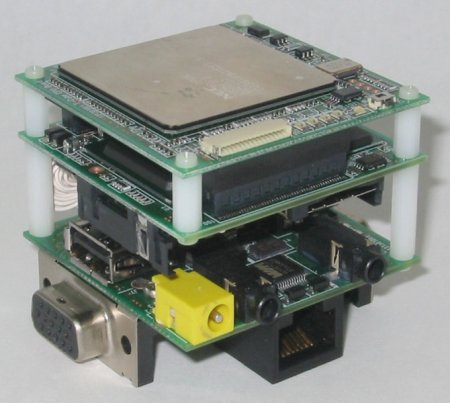
Sumafuji's earlier SEMC5701 (not latest “B” rev)
(Click to enlarge)
The Teacube was also based on the MIPS-based VR5701 processor and offered very similar specs. In fact, although it ran TRON out of the box, it was verified to work with Red Hat. The key difference with the Space Cube is the addition of the SpaceWire port, which is similar to the iEEE1394 Firewire standard and is said by Shimafuji to offer similar port speeds.
Based on iEEE1355, SpaceWire is the common name for the European Cooperation on Space Standardization ECSS-E50-12A standard, which is intended as a common port to connect devices from various space programs. SpaceWire has been adopted by the European Space Agency, the Japanese space agency, and NASA, and is used today on the International Space Station.
According to a recent review by UK-based PC-Pro, which acquired the latest prototype, the final commercial version of the Space Cube will soon be sold by Star-Dundee of Scotland for a whopping 1,500 British Pounds. Star-Dundee is a spin-out from the Space Systems Research Group of the University of Dundee in Dundee, Scotland and specializes in SpaceWire, selling a variety of Linux-compatible SpaceWire-enabled routers, testers, USB bricks, PCI boards, and other gadgets.
The review praised the “utterly rock solid” construction of the Space Cube, and the amazing number of connections it manages to fit into such a small frame, including jumpers that enable overclocking. Not surprisingly, the reviewers were unable to test out the SpaceWire connection, which they indicate is a proprietary interface.
The review tested the system as drawing a low 5 Watts of power, and reports that “for such a small and low-powered PC, the Space Cube is actually pretty nippy.” The reviewers suggest that “amateur robotics and rocket clubs” might be interested, and that “the open-ended Linux installed here will no doubt prove versatile and able to be used for a variety of suitably scientific purposes.” The review concludes with no faint praise indeed: “It's tiny, brilliant, and astounding, and we're huge fans.”
Availability
No information was made about the commercial availability of the Space Cube. More on the Space Cube can be found on this Google-translated Shimafuji page. The full PC Pro review may be found here.
This article was originally published on LinuxDevices.com and has been donated to the open source community by QuinStreet Inc. Please visit LinuxToday.com for up-to-date news and articles about Linux and open source.